Congratulations to #10.000 postings.
Why should this not be a real issue? It appears to happen most strongly on the far off-axis vertical angles, so the 'issue', whether it is due to inferior measuring or actually in the physics of the device, lies in the extended termination. Maybe it does act like a baffle, which due to its presense creates huge pressure differences that show up in the response elsewhere. The frequency area is fitting.
Why should this not be a real issue? It appears to happen most strongly on the far off-axis vertical angles, so the 'issue', whether it is due to inferior measuring or actually in the physics of the device, lies in the extended termination. Maybe it does act like a baffle, which due to its presense creates huge pressure differences that show up in the response elsewhere. The frequency area is fitting.
Of course it can be real. I only know from my experience that a 3D model is seldom as smooth as the same model in the CircSym mode (which has been confirmed by measurements many times) and it doesn't have to be an obvious numerical glitch but even something like this.
If we observed that it changes e.g. with a different interface, we would simply know that it can't be trusted.
If we observed that it changes e.g. with a different interface, we would simply know that it can't be trusted.
I found that a halo that extended from the back of the termination to cover a larger volume forwards gave the result that was most similar to circsym.
https://www.diyaudio.com/community/...aker-build-abec-modelling.357792/post-6510039
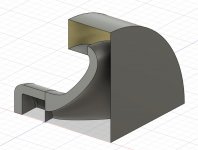
https://www.diyaudio.com/community/...aker-build-abec-modelling.357792/post-6510039

No matter what I do I still have the sameWhat you could also try is to decrease the Mesh.SubdomainSlices by one or two (and perhaps decrease Mesh.InterfaceOffset then, only check that the interface doesn't intersects the WG). This changes the position and shape of the interface, which can have quite a strong effect on the result for a 3D model (which is unfortunate but there's probably no other way).
There's also an option to set Mesh.RearShape = 2. Once I tried to match an axisymmetric model with the same one in 3D and with this setting it was the closest, IIRC.
Mesh.RearShape = 2 seems to helps for the V plan.
V
H
Z=
maiky, fluid's interface was going all around the back of termination.
Here is another puzzle: The baffled waveguide I was working on shows issues in a full enclosure, and as can be seen here https://www.diyaudio.com/community/...708-ish-dimensioned-2-way.377634/post-7004835, this is also visible in DI plots. This vertical issues also bleed through to horizontal.
So I wanted to see if I could optimize in quarter sym, and there the issue is not even present. What can be seen is the same waveguide, the rugged plot stems from a full enclosure simulation with 150 frequencies, the clean from a quarter sym with 100 frequencies, everything else being equal. The full enclosure plot is for the vertical up-axis and edge distances and rounding are identical with the quarter sym:
1/2
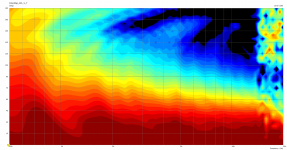
1/4
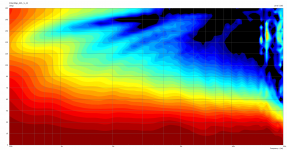
Here is another puzzle: The baffled waveguide I was working on shows issues in a full enclosure, and as can be seen here https://www.diyaudio.com/community/...708-ish-dimensioned-2-way.377634/post-7004835, this is also visible in DI plots. This vertical issues also bleed through to horizontal.
So I wanted to see if I could optimize in quarter sym, and there the issue is not even present. What can be seen is the same waveguide, the rugged plot stems from a full enclosure simulation with 150 frequencies, the clean from a quarter sym with 100 frequencies, everything else being equal. The full enclosure plot is for the vertical up-axis and edge distances and rounding are identical with the quarter sym:
1/2

1/4

Yes, -30 to 0 db, 1 dB increments, normalized to on-axis.
The deep notch that rips through the pattern right above 1k makes it much harder to get a smooth crossover: either, energy is missing around 1k, or excessive energy, especially off-axis, develops between 1.6 and 2k. I would like to understand the cause of this and if it can be corrected.
Is it purely the box below?
The deep notch that rips through the pattern right above 1k makes it much harder to get a smooth crossover: either, energy is missing around 1k, or excessive energy, especially off-axis, develops between 1.6 and 2k. I would like to understand the cause of this and if it can be corrected.
Is it purely the box below?
Here is the same for horizontal. The vertical bleeds through.
1/2
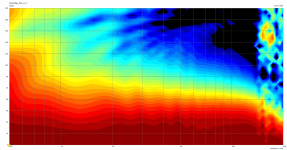
1/4
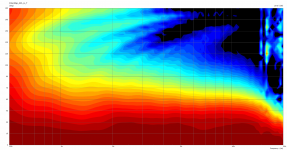
So here is one question: At 500 Hz, one can see in the far off-axis angles reduced pressure, that is kind of shifted towards middle angles sligthly higher, bulging up and probably creating the accentuated diffraction dip. What is causing the reduced pressure in far off-axis angles, in 1/2 symmetry compared to 1/4?
1/2

1/4

So here is one question: At 500 Hz, one can see in the far off-axis angles reduced pressure, that is kind of shifted towards middle angles sligthly higher, bulging up and probably creating the accentuated diffraction dip. What is causing the reduced pressure in far off-axis angles, in 1/2 symmetry compared to 1/4?
I think you are paying too much attention to the simulation at this point. With real transducers it will be different anyway. Simulation can prove concepts, show a rough guideline what might be a good idea but not the details at this level...The deep notch that rips through the pattern right above 1k makes it much harder to get a smooth crossover: [...]
Hi
this awesome thread hat now over 500 pages. I started studying it and already found many hints to start with ATH. However there are few questions I would be happy if someone could give me a answer:
this awesome thread hat now over 500 pages. I started studying it and already found many hints to start with ATH. However there are few questions I would be happy if someone could give me a answer:
- Is there now any kind of list of already used drivers? Or a general recommendation? Especially with regard of low Xo frequency in home hifi use?
- I can so far use the input script. But is there any acces to the solver mabat is using? For me I change a parameter; wait; evaluate; change; wait;...... I understood he is doing a whole batch of simulations at once to study influence of single parameters
- Just an idea: a compression driver using a ring radiator usually bends the wavefront the mylar membrane radiates 180° to the exit. I saw some concepts (Coda-Audio) where this is ommited and the ring radiator "ring" radiates directly in a waveformer. The mechanical mod on theese drivers seem easy (all BMS drivers are more or less similar). Would this somehow help for wavefront-shaping? See: https://codaaudio.com/de/ddp-ddc-treiber/ In the video you can see 1 reversed and 1 directly radiating rings into the waveformer. No need to push through a hole and no need to reverse-radiate if only using 1 diaphragm.
I can so far use the input script. But is there any acces to the solver mabat is using? For me I change a parameter; wait; evaluate; change; wait;...... I understood he is doing a whole batch of simulations at once to study influence of single parameters
I use AutoIT (and mabat too if I'm correct). Here is my script:
Code:
#include <File.au3>
For $i = 1 To 200
$qRandom = Random(4.0, 7.0)
$rRandom = Random(0.2, 0.4)
$mRandom = Random(0.7, 0.9)
$bRandom = Random(0.05, 0.25)
$kRandom = Random(1.0, 2.0)
$aRandom = Random(40, 40)
_FileWriteToLine("C:\Users\User\Programs\AdvancedTransitionHorn\4.8.2\demo\R-OSSE.cfg", 3, " a0 = " & String($aRandom), True)
_FileWriteToLine("C:\Users\User\Programs\AdvancedTransitionHorn\4.8.2\demo\R-OSSE.cfg", 6, " k = " & String($kRandom), True)
_FileWriteToLine("C:\Users\User\Programs\AdvancedTransitionHorn\4.8.2\demo\R-OSSE.cfg", 7, " r = " & String($rRandom), True)
_FileWriteToLine("C:\Users\User\Programs\AdvancedTransitionHorn\4.8.2\demo\R-OSSE.cfg", 8, " m = " & String($mRandom), True)
_FileWriteToLine("C:\Users\User\Programs\AdvancedTransitionHorn\4.8.2\demo\R-OSSE.cfg", 9, " b = " & String($bRandom), True)
_FileWriteToLine("C:\Users\User\Programs\AdvancedTransitionHorn\4.8.2\demo\R-OSSE.cfg", 10, " q = " & String($qRandom), True)
ShellExecute("C:\Users\User\Desktop\ath.lnk")
WinWaitActive("ath")
Send("ath.exe demo/R-OSSE.cfg{ENTER}")
ShellExecute("C:\ProgramData\Microsoft\Windows\Start Menu\Programs\RDTeam\ABEC3.lnk")
WinWaitActive("ABEC3")
Send("^o")
WinWaitActive("Openen")
Send("Project.abec{ENTER}")
WinWaitActive("ABEC3 - ABEC_FreeStanding")
Send("{F5}")
WinWaitActive("Confirm")
Send("{ENTER}")
Sleep(25000)
WinWaitActive("ABEC3 - ABEC_FreeStanding")
Send("{F7}")
Sleep(8000)
;~ WinClose("VacsViewer - (new) - [PolarMap_SPL]")
;~ Send("n")
;~ WinActivate("ABEC3 - ABEC_FreeStanding")
;~ WinWaitActive("ABEC3 - ABEC_FreeStanding")
Send("^{F7}")
WinWaitActive("Information")
Send("{ENTER}")
WinClose("ABEC3 - ABEC_FreeStanding")
Send("{ENTER}")
WinActivate("ath")
WinWaitActive("ath")
Send("ath.exe demo/R-OSSE.cfg -r{ENTER}")
Sleep(1000)
WinClose("ath")
FileMove("C:\Users\User\Qsync\Hifi\Horns\R-OSSE\ABEC_FreeStanding\Results\R-OSSE.png", "C:\Users\User\Qsync\Hifi\Horns\R-OSSE\ABEC_FreeStanding\Results\R-OSSE_a="& String($aRandom) & "_k=" & String($kRandom) & "_r=" & String($rRandom) & "_m=" & String($mRandom) & "_b=" & String($bRandom) & "q=" & String($qRandom) & ".png")
NextMaiky76 also has an optimizer (I did some work on that too), but currently it is not freely available.
I have a raw prototype scaled 1:2 for the B&C DE7 (not measured yet) -1.4" throat, 460 x 240 mm.
- Is there now any kind of list of already used drivers? Or a general recommendation? Especially with regard of low Xo frequency in home hifi use?
Most popular/highly appreciated: Faital Pro HF108.
Other drivers tested: BMS 4550, 18Sound ND1090/NSD1095N, Tymphany DFM-2535R00-08 (I'd prefer the 2544R00-08).
Worth considering: B&C DE250/DE400(Tn)/DE500, Celestion CDX1-1740/1747, RCF ND340/350.
- Just an idea: a compression driver using a ring radiator usually bends the wavefront the mylar membrane radiates 180° to the exit. I saw some concepts (Coda-Audio) where this is ommited and the ring radiator "ring" radiates directly in a waveformer. The mechanical mod on theese drivers seem easy (all BMS drivers are more or less similar). Would this somehow help for wavefront-shaping? See: https://codaaudio.com/de/ddp-ddc-treiber/ In the video you can see 1 reversed and 1 directly radiating rings into the waveformer. No need to push through a hole and no need to reverse-radiate if only using 1 diaphragm.
Those BMS couplers are specifically designed for Line-Arrays, in order to produce either a flat or 20° curved wavefront, intended for stacking multiple small cabs to cover large spaces.
While the technology works very well for sound reinforcement (beam steering), it's not particularly useful at home. Unless your room is the size of a hallway.
Last edited:
There seem to be many versions of the Scotch-Weld - which one are you using?Regarding the glue, I have the 3M Scotch-Weld, a few drops are more than enough...
//
I think is was PR100 but only becaue I had it at hand, it absolutely doesn't matter, IMO, you could as well use the cheapest one you find anywhere. I would only strongly recommend to think twice about the glue and the technique - the CA requires really a lot of careful work (depending on what you want to do).
- BTW, it's no problem to print it like this. I guess it would be as well possible to print the whole WG as one piece, it would only take much more time. As usual, I print the mouth part hollow (two 0.6mm perimeters), there's no problem with that.



I'll prepare a 1" version, something like the ST260 / ⌀260 mm. That still fits the volume of Ender 6.
I'll prepare a 1" version, something like the ST260 / ⌀260 mm. That still fits the volume of Ender 6.
Last edited:
- Home
- Loudspeakers
- Multi-Way
- Acoustic Horn Design – The Easy Way (Ath4)